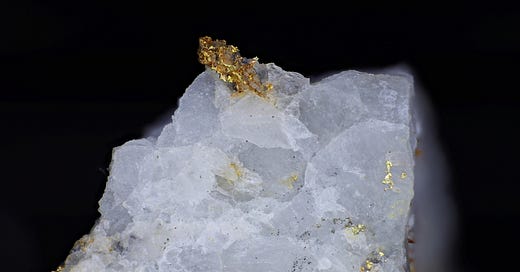Tasmania doesn’t measure up to other States like Victoria or Western Australia when it comes to gold, but it is widespread, and it still has its moments.
One of these in particular, is the unusual occurrence of gold in fluorite from the Hercules Mine in western Tasmania.
The Mineralogical Society of Tasmania was privileged to be able to visit this historic mine on Sunday 23rd February, 1997. Here is the information about the mine as per a field trip report I wrote at the time (note that ownership may have changed since then).
The Hercules mine is situated on the side of Mt Hamilton (1,075m), part of a belt of Cambrian rocks known as the Mt Read volcanics, and is about 7km south of Rosebery in western Tasmania. It comprises a number of predominantly zinc sulphide lenses, and mineralisation occurs over a total length of 1,000m with a vertical depth of more than 250m.
The southern section of the deposit was discovered in 1891 and was originally known as the Mt Read mine, with the Hercules section 300m north, discovered in 1894. Initially, both were worked separately with production commencing in 1900 after the haulage to Williamsford and the rail link from Williamsford to Zeehan were completed. Ore was transported to the Tasmanian smelters at Zeehan. It was difficult, even in the early years, to ensure the success of the mine. Twelvetrees reported that low metal prices and an increased production from the Broken Hill mines (New South Wales) would make it difficult to make a profit.
The two properties were subsequently amalgamated under the name Hercules and purchased in 1920 by the Electrolytic Zinc Company (now known as Pasminco Rosebery). Adits were constructed at seven levels into the mountain, the lowest being at 682 metres. The ore was conveyed to Rosebery by aerial ropeway. The ropeway was 6.4 km long with 65 towers, most of which are still standing, and 194 buckets. The Hercules ore was mixed with ores from Rosebery, Tullah and later, Que River, for the EZ smelters (now Pasminco Hobart) at Risdon in Hobart.
Pasminco still hold the lease over the Hercules but no work had been undertaken for a number of years. Mancala, an Australian company that specialises in the operation of small, sub-economic (by the standards of the day) orebodies, are now operating the mine under a sub-licence agreement which allows them to work the number six and seven levels of the mine over a two year period. Mancala recently finished a similar operation at the Anchor tin mine at Lottah in northeast Tasmania.
The Hercules, as was the case with many west coast mines, required ingenious methods to overcome the typical obstacles of height, steep terrain and high rainfall. Here, a self acting haulage connected the workings with the northeast Dundas tramway near the township of Williamsford. This haulage was 1 mile (1.6km) long and 1,642 feet (550m) high with a maximum gradient of 1 in 5. In the early part of this century, permission to ride the haulage could be obtained from the mine management. This was noted as a "unique experience"; surely an understatement.
Below: Gold, Fluorite, Hercules Mine, Williamsford, Rosebery district, West Coast municipality, Tasmania. Width of view 11.5mm.





beautiful specimen Steve, did you collect it? Do you have any photos of the infrastructure? sounds like a real feat of engineering.. Marg
Very unusual association. The fluorite looks highly fractured. Wonder what the black micro specks might be. Bill.